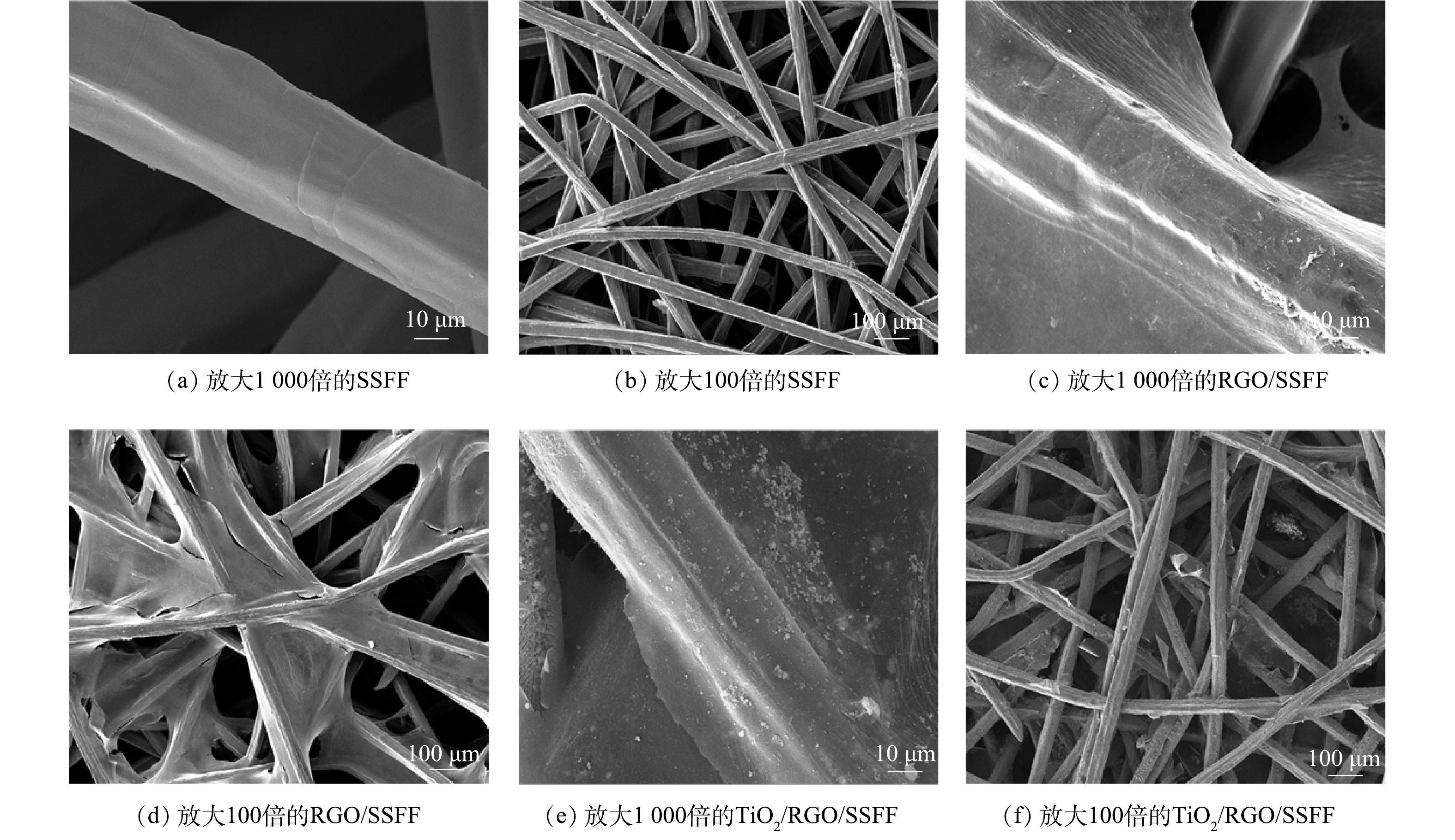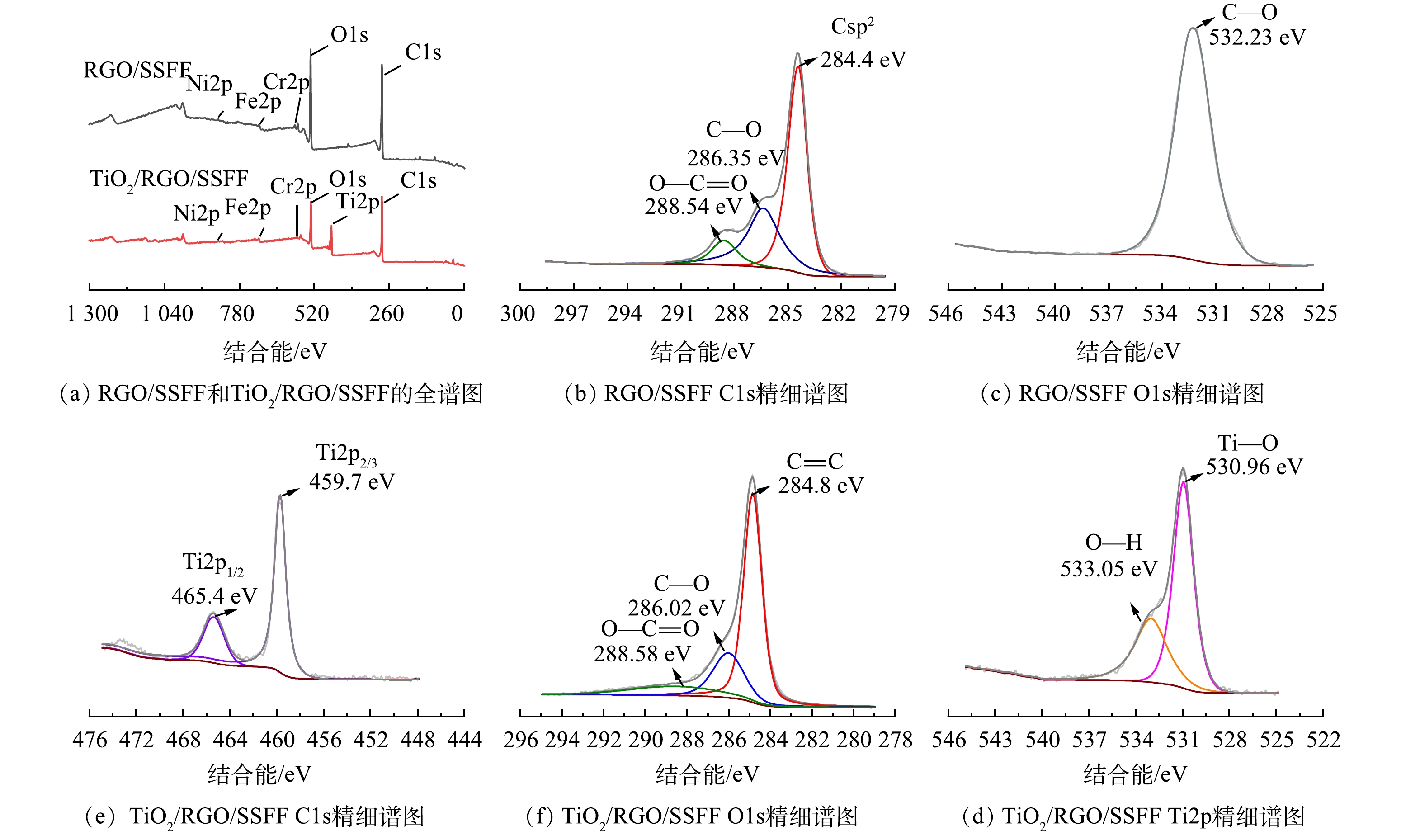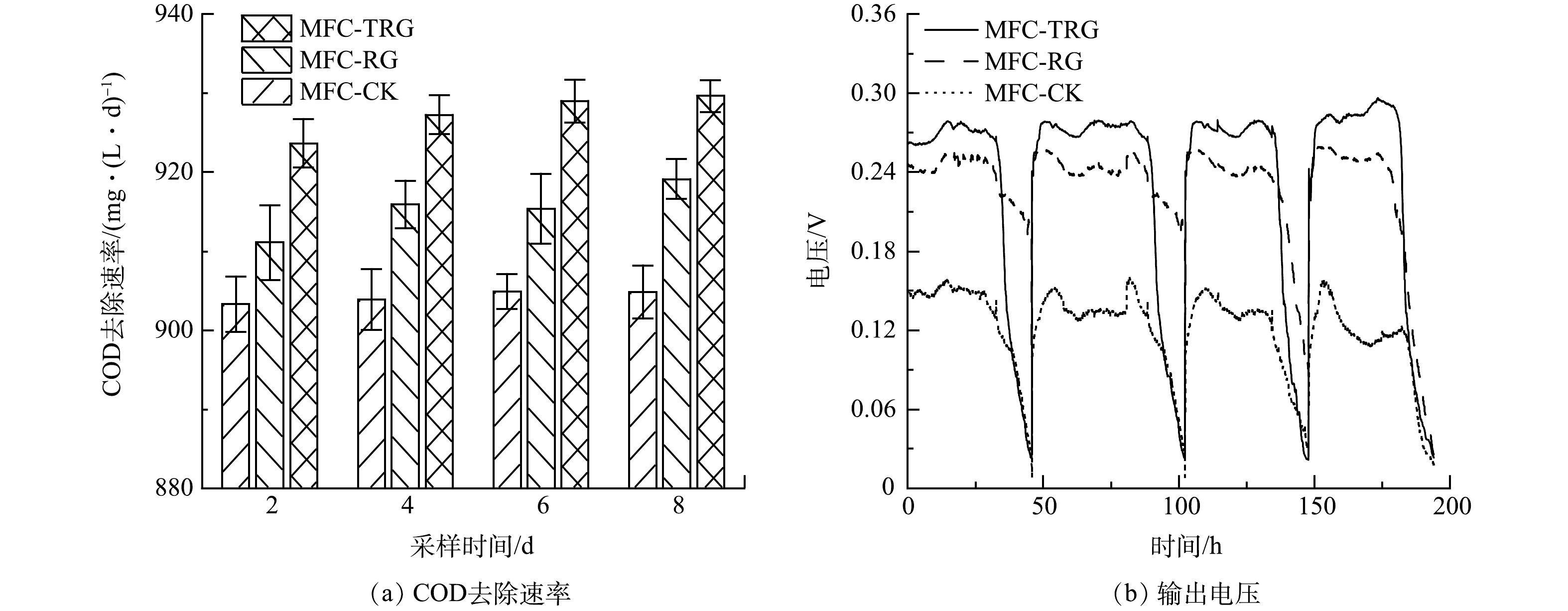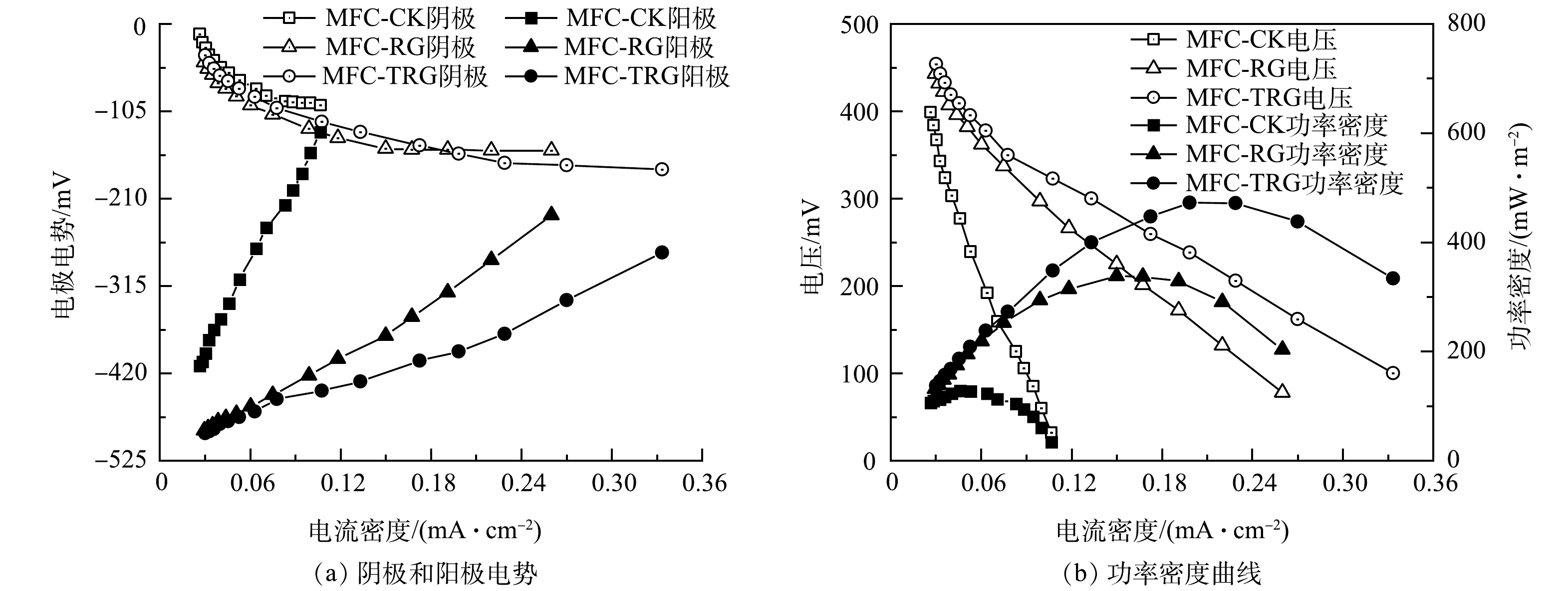-
微生物燃料电池(microbial fuel cell, MFC)是一种能同步处理废水与产电的绿色技术,其阳极微生物能够通过氧化废水中的有机物以产生电子和质子氢。电子通过直接/间接的方式传递至阳极表面并进一步通过外电路传输至阴极,质子氢通过质子交换膜传递到阴极,从而形成回路产生电流[1-2]。阳极材料在MFC运行中起到关键作用,主要影响微生物的生长与附着及电子传递[3]。
理想的阳极材料应具有良好的生物相容性、高比表面积、高电子转移速率、强稳定性、高孔隙率、低成本、易制备等特点[3-4]。传统的MFC阳极材料多以碳材料为基底,虽然碳材料具有良好的生物相容性,但其导电性差、电子转移速率低、强度低、易变形和价格昂贵等缺点限制了其产电性能和实际应用[5]。与传统碳材料(碳布、碳纸)相比,不锈钢纤维毡(stainless steel fiber felt, SSFF)具有高导电性、三维多孔固体结构、良好的耐腐蚀性和价格低廉等优势,是理想的基底材料[6-7]。GUO等[6]将热处理后的SSFF作生物电化学系统的阳极材料获得的电流密度是未热处理的7倍;HOU等[7-8]通过浸渍法、电聚合等方法分别制备了羧基石墨烯/SSFF、碳纳米管/SSFF、聚苯胺/SSFF和活性炭/SSFF阳极并应用在MFC阳极中,分别获得了650、620、580和451 mV的稳定输出电压。这表明SSFF具有作为MFC基材的潜力,但SSFF较差的生物相容性和高过电位限制了其在生物电化学系统中作为阳极的应用[9],因此需要对SSFF进行表面修饰以提高生物相容性和电子转移速率。
石墨烯作为一种新型碳纳米材料,具有高比表面积、高电导率和良好的生物相容性等特点,一直是材料改性研究的一大热点[10-11]。侯俊先[4]通过先浸渍后电化学还原的方法将还原氧化石墨烯(reduced graphene oxide, RGO)负载在SSFF上作为MFC阳极,获得了4.45 A·m−2的最大电流密度,是SSFF阳极-MFC的1.6倍。原诗瑶[12]通过水热反应法制备了RGO/MnO2/泡沫镍阳极并应用在MFC中,获得了643.9 mW·m−2的最大功率密度,是泡沫镍阳极-MFC的2.6倍。这表明SSFF和泡沫镍经RGO修饰后均能改善MFC的产电性能。二氧化钛(TiO2)作为一种半导体金属氧化物,由于良好的生物相容性、亲水性和无毒性,在锂电池和生物传感器等领域中得到广泛应用[13-14]。JIA等[13]制备了纳米TiO2/碳纸作为MFC阳极,获得了392 mW·m−2的最大功率密度,比未修饰的碳纸高50%。因此,对SSFF进行RGO和纳米TiO2修饰,有望在保留SSFF高导电性和耐腐蚀性的同时改善SSFF的生物相容性,将改性材料应用于MFC阳极中有望同步处理废水与高效产电。
本研究以SSFF为基底,以GO和纳米TiO2为原料制备改性材料RGO/SSFF和TiO2/RGO/SSFF,以SSFF为对照,通过电化学测试和物理表征分析材料的电化学特性、物理结构和表观形貌,将SSFF、RGO/SSFF和TiO2/RGO/SSFF分别作为构建的MFC的阳极,对其产电性能和COD去除速率进行探究,旨在为后续MFC阳极改性研究提供参考。
-
本实验所采用的主要药品和材料包括P25二氧化钛(AR,上海麦克林生化科技有限公司)、氧化石墨烯(AR,苏州碳丰科技有限公司)、抗坏血酸(AR,西陇科学股份有限公司)、无水乙醇(AR,西陇科学股份有限公司)和不锈钢纤维毡(316L,过滤精度≥100 μm,厚0.6 mm,迈鹏辰电子科技有限公司)。
-
1) 材料预处理。将SSFF裁剪为长3 cm、宽1.5 cm的方形片,先在丙酮中超声20 min,RO水冲洗;再放入无水乙醇中超声20 min,RO水冲洗;再放入1 mol·L−1的H2SO4 中浸泡 2 h,RO水冲洗;最后在RO水中超声20 min取出,60 °C烘箱中烘12 h,获得SSFF(对照组)。
2) RGO/SSFF的制备。分别配制3 g·L−1的氧化石墨烯(graphene oxide, GO)溶液和抗坏血酸(LAA)溶液,GO溶液超声至分散后,将LAA溶液倒入,将混合溶液超声20 min。再将SSFF放入混合溶液中,超声5 min。然后将SSFF转移到反应釜中,用移液枪吸取100 μL的混合溶液,均匀滴在SSFF表面,反应釜在100 °C烘箱反应2 h;待反应釜冷却至室温后,取出材料,RO水冲洗,60 °C烘箱中烘12 h,获得RGO/SSFF。
3) TiO2/RGO/SSFF的制备。称取0.05 g的纳米TiO2粉末,加入10 mL的无水乙醇,超声20 min,得到稳定的纳米TiO2-无水乙醇悬浊液。将制备好的RGO/SSFF标记为A、B两面,将A面朝上放入悬浊液,浸渍12 h后,80 °C 烘箱内干燥2 h。烘干后,在B面重复以上操作,最后将负载完成的材料放入350 °C马弗炉中,负载固定化2 h,自然冷却后取出,获得 TiO2/RGO/SSFF。
-
利用电化学工作站(CHI660e,上海辰华仪器有限公司)的三电极体系(工作电极(SSFF、RGO/SSFF和TiO2/RGO/SSFF)、对电极(铂片电极)和参比电极(R232饱和甘汞电极)),对SSFF、RGO/SSFF和TiO2/RGO/SSFF进行循环伏安(CV)曲线、塔菲尔(Tafel)曲线和电化学阻抗谱(EIS)测试。测试时使用250 mL密封电解槽,电解液为5 mmol·L−1铁氰化钾溶液,CV 测试扫描范围为0.7~1.1 V,扫描速度为 25 mV·s−1。EIS测试频率为 0.1~1 000 kHz。Tafel 测试的扫描电压为0.72~1.65 V,扫描速度为10 mV·s−1。电容(Q)和交换电流(i0) 的计算方法参见本课题组已有的研究[15]。
-
采用扫描电子显微镜(SEM,捷克TESCAN MIRA LMS)、全自动比表面及孔隙度分析仪(BET,美国Micromeritics ASAP)、原位红外分析仪(FTIR,美国Frontier)、X射线衍射仪(XRD,日本Rigaku SmartLab SE)、X射线光电子能谱仪(XPS,美国Thermo Scientific K-Alpha)分别对材料的形貌、比表面积、官能团、晶体结构、分子结构和元素价态等方面进行表征。由于块状样品在FT-IR、XRD测试中不易出峰,因此使用刀片刮取样品表面粉末后再进行测试。
-
本实验采用双室MFC,由2个四方形有机玻璃及2个挡板组成,中间用质子交换膜(杜邦N117,苏州晟尔科技有限公司)隔开。单室内部均为直径5.5 cm、深5 cm的圆柱形室,有效容积约为118 mL。阴极材料(长4 cm,宽2 cm,厚0.5 cm)采用碳毡。以SSFF、RGO/SSFF、TiO2/RGO/SSFF作为阳极材料(长1.5 cm,宽1 cm,厚0.12 cm)的MFC装置分别命名为MFC-CK、MFC-RG和MFC-TRG。用钛丝连接阴阳电极和外电路,外电路接1 000 Ω的电阻。阳极室厌氧污泥采自桂林市秀峰区漓泉啤酒厂厌氧池。每个反应器阳极添加20 mL的厌氧污泥和90 mL的营养液,阴极添加90 mL 50 mmol·L−1 磷酸盐缓冲液(PBS),阴极曝气。3组MFC同时运行,每2 d更换一次阳极液。1 L阳极营养液的基本成分为2.56 g乙酸钠、50 mmol·L−1 PBS和1 mL微量营养液。微量营养液的配制参见LIU等研究中的方法[16]。
-
每周期结束时,在取样口取5 mL水样 (取3次)用于测定出水COD,测定方法为重铬酸钾微波消解法。
用电脑连通 LabQuest mini 主机并连接电压传感器 DVP-BTA(威尼尔软件与技术公司,美国),每5 min记录一次外接电阻两端的电压。在第4周期结束后,断开外接电阻,监测开路电压。当开路电压达到最大值时,接入可调节电阻箱(23023型简式电阻箱,中秦教学设备有限公司,中国),采用万用表(VC990C+,深圳胜利仪器仪表有限公司,中国)由高到低测定不同外电阻(200~9 999 Ω)下的阴、阳极电势及输出电压,电压稳定时间为30 min。根据输出电压和阳极表面积(1.5 cm2)计算功率密度并绘制功率密度曲线[15]。
-
通过电化学测试探究材料改性前后的电化学性能。由循环伏安曲线(图1(a))可计算出SSFF、RGO/SSFF和TiO2/RGO/SSFF的电容,分别为326.8、413.9和446.9 mF,由此可以看出,SSFF经修饰后电容增大[17]。此外,3种材料的循环伏安曲线都出现了明显的氧化和还原峰,SSFF、RGO/SSFF和TiO2/RGO/SSFF的氧化峰电流分别为10.42、12.72和12.85 mA,其氧化电流/还原电流之比(x)分别为1.21、1.004和1.06。x越趋近于1,电极反应的可逆性就越高[15]。3种材料氧化峰和还原峰的峰电位差(ΔE)分别为1.597 V(SSFF)、1.342 V(RGO/SSFF) 和1.038 V(TiO2/RGO/SSFF)。ΔE越小,材料转移的电子数量越多[18],表明RGO/SSFF和TiO2/RGO/SSFF具有更强的电子转移能力。这可能得益于RGO良好的导电性和纳米TiO2优异的电催化性能[10, 13]。
3种材料的塔菲尔曲线及线性拟合曲线(拟合区间为1.2~1.55 V)如图1(b)和图1(c)所示。根据拟合曲线公式计算出TiO2/RGO/SSFF和RGO/SSFF的交换电流(i0),分别是SSFF(i0=9.49×10−7 mA)的218.4倍和16.4倍,表明TiO2/RGO/SSFF和RGO/SSFF具有更快的氧化还原速率。该结果进一步证实了修饰在SSFF上的RGO和纳米TiO2均可提高SSFF的电子转移速率[19]。
图1(d)和图1(f)为3种材料经Zview2软件拟合得到的奈奎斯特图及拟合所用等效电路图。等效电路图由溶液电阻(Rs)、界面转移电阻(Rct)、双电层电容(Cdl)和韦伯阻抗电阻(W)构成[20]。SSFF、RGO/SSFF和TiO2/RGO/SSFF的Rct分别为21.45、19.65和18.16 Ω。界面转移电阻越小,材料电子转移能力越强,表明GO和纳米TiO2 对SSFF的修饰使其电子转移能力得到增强 [10, 14]。RGO/SSFF和TiO2/RGO/SSFF的W分别为3.116 和4.746 Ω,均小于SSFF(W=6.01 Ω)。W越小越有利于电子传递,离子向电极界面的扩散能力越强 [15]。此外,SSFF、RGO/SSFF和TiO2/RGO/SSFF的Cdl分别为2.31×10−5、2.67×10−5和2.78×10−5 mF。SSFF经修饰后双电层电容增大,表明RGO/SSFF和TiO2/RGO/SSFF上电荷储存和释放过程比SSFF更易进行,这可归因于RGO的负载[21]。
-
SSFF、RGO/SSFF和TiO2/RGO/SSFF的SEM图如图2所示。可以看出:SSFF表面光滑,具有立体的三维结构(图2 (a)和图2 (b));RGO薄膜成功包覆在SSFF的骨架上形成RGO/SSFF(图2 (c)和图2 (d)) ;纳米TiO2成功负载在RGO/SSFF上,形成TiO2/RGO/SSFF(图2 (e)和图2 (f))。
SSFF、RGO/SSFF和TiO2/RGO/SSFF的等温吸脱附曲线和BET测试结果见图3和表1。SSFF的等温线类型确定为Type-Ⅲ型(图3(a)),是典型的固体材料吸脱附曲线[22]。RGO/SSFF和TiO2/RGO/SSFF的等温线类型均为Type-Ⅳ型(图3(b)和图3 (c))。TiO2/RGO/SSFF的等温线在0.5~1.0相对压力区间内,有更明显的H3型回滞环,为介孔结构,这一现象可归因于纳米TiO2的负载[23]。 RGO/SSFF和TiO2/RGO/SSFF的比表面积分别是SSFF(0.57 m²·g−1)的2倍和1.58倍,吸附平均孔径分别是SSFF(5.63 nm)的 1.39倍和4.19倍。
图4(a)为GO、RGO和TiO2/RGO的红外光谱图。在GO的图谱中,在3 422 cm−1处出现了O—H的伸缩振动峰,这可归因于GO中的结合水[24-25];在1 621 cm−1处为C=C的骨架振动峰,1 733 cm−1处为C=O的伸缩振动峰,1 176 cm−1和1 030 cm−1处分别为C—O的弯曲振动峰和伸缩振动峰[23, 26]。与GO相比,在RGO图谱中,3 422、1 621、1 176和1 030 cm−1处出现的含氧官能团的峰,强度都大幅度减小甚至消失,表明GO成功被还原并负载在SSFF上[23-24]。在TiO2/RGO图谱中,在1 632 cm−1处出现了C=C的骨架振动峰,在669 cm−1 处出现了TiO2的特征峰,表明TiO2和RGO在SSFF上成功负载[27],这与SEM结果一致。
图4(b)为GO、RGO和TiO2/RGO的XRD图。在GO的图谱中,2θ为9.38°和42.82°处分别出现一强一弱的衍射峰,分别对应GO的(001)和(100)晶面[28]。这主要是因为GO中含有大量的含氧基团 [26, 28]。在RGO的图谱中,2θ为25.34°和42.82°时出现的特征峰分别对应RGO的(002)和(100)晶面[29]。与GO图谱相比,2θ为9.38°的强衍射峰消失,在25.34 °出现了一个新的较宽的衍射峰,表明GO成功被还原,由于石墨烯片层较小且形状无规则,所以形成较宽的衍射峰[19, 30];在TiO2/RGO的图谱中,TiO2(锐钛矿)晶面所对应的2θ角分别为25.4°(101)、37.06°(103)、37.9°(004)、38.7°(112)、48.18°(200)、54.06°(105)、55.22°(211)、62.86°(204)、68.96°(116)、70.34°(220)、75.3°(215)和82.74°(224),表明纳米TiO2成功负载在材料上。然而,RGO的衍射峰未在TiO2/RGO中显现,这是因为TiO2的负载使RGO的衍射峰峰趋于平缓,这与CAO等[31]的测试结果相一致。
RGO/SSFF和TiO2/RGO/SSFF的XPS结果如图5所示。由图5(a)可以看出,RGO/SSFF和TiO2/RGO/SSFF主要由C、O、Fe、Cr、Ni、Ti 6种元素组成,Fe、Cr、Ni是基底SSFF所具有的金属元素[32]。图5(b)中284.4、286.35和288.54 eV处出现的峰分别对应RGO的Csp2、C—O和O—C=O键[33];图5(c)中532.23 eV处出现的峰对应C—O键,与C1s峰测量结果相对应[22],表明RGO成功负载至SSFF上;图5(e)中284.8、286.02和288.58 eV处出现的峰分别对应RGO的C—C、C—O和O—C=O键[34];图5(f)中530.96 eV和533.05 eV处出现的峰分别对应Ti—O键和O—H键[24];图5(d)中465.4 eV和459.7 eV处出现的峰分别对应Ti2p1/2和Ti2p3/2,表明Ti4+的存在[35-36]。这些结果表明RGO和纳米TiO2均成功负载至SSFF。
-
不同阳极MFC的COD去速效率和稳定输出电压如图6(a)和图6(b)所示。MFC-TRG、MFC-RG和MFC-CK的 COD去除速率分别为929.62、919.12和904.80 mg·(L·d)−1,COD去除率均在90%以上。周期初始时阳极营养物质充足,电压快速稳定,直到底物耗尽,电压快速下降(图6(b))。这一运行规律与其他研究[21, 37] 一致。与其他研究(表2)相比,本研究具有更高的COD去除速率。MFC-TRG的稳定输出电压为280 mV,分别比MFC-RG(245 mV)和MFC-CK(130 mV)高14.3%和115.4%。这可能是因为修饰的RGO 改善了SSFF的生物相容性,从而促使微生物更好地附着生长[38-39],同时纳米TiO2进一步促进了微生物/电极界面的电子转移[30]。
MFC的阴阳极电势和功率密度曲线如图7(a)和图7(b)所示。可以看出,当电流密度从0 mA·cm−2增大到0.1 mA·cm−2时,MFC-CK、MFC-RG和MFC-TRG的阳极电势分别提高了62.23%、13.50%和10.36%。MFC-TRG的阳极电势变化幅度更小,表明其具有更好的阳极性能和更稳定的生物膜[37]。在相同电流密度范围内,MFC-TRG的电压降幅明显小于MFC-RG和MFC-CK(图7(b)),电压的降低主要受欧姆极化和传质损耗影响。欧姆损耗主要受阳极的内阻影响,传质损耗主要归因于还原化合物向电极供应氧化化合物有限或有限放电能力[15, 40]。该结果表明MFC-TRG具有更小的内阻。MFC-TRG最大功率密度为472.03 mW·cm−2 ,是MFC-RG和MFC-CK的1.4倍和3.7倍。本研究所获得的最大功率密度优于表2中的部分研究[7, 13, 41-44]。与GUO等[41]报道的RGO/碳纸阳极-MFC相比,本研究中MFC-TRG获得的功率密度是其功率密度(368 mW·cm−2)的1.28倍。同时,本研究与侯俊先[4]报道的恒电位法制备的RGO/SSFF阳极-MFC(2393 mW·m−2)相比,尚存一定的差距。这可能是其阳极接种微生物经过1 a的驯化或采用铁氰化钾作为阴极液导致的。
-
1) 电化学性能测试结果表明,与SSFF相比,修饰后的RGO/SSFF和TiO2/RGO/SSFF具有更大的电容、更强的电子转移能力、更低的界面转移电阻和更高的交换电流密度。
2) SEM、FT-IR、XRD和XPS分析结果证实了RGO和纳米TiO2成功负载于SSFF基底材料上。RGO/SSFF和TiO2/RGO/SSFF的BET比表面积分别是SSFF的2倍和1.58倍。
3) 与MFC-RG和MFC-CK相比,MFC-TRG具有更高的 COD去除速率(929.62 mg·(L·d)−1)和输出电压(280 mV)。MFC-TRG和MFC-RG的输出功率密度分别为472.03 mW·m−2和337.50 mW·m−2,均高于MFC-CK。
不锈钢纤维毡改性材料的制备及在微生物燃料电池中的应用
Preparation of stainless-steel fiber felt modified material and its application in microbial fuel cell
-
摘要: 为制备一种导电性高、生物相容性良好且耐腐蚀的阳极材料,提高微生物燃料电池(MFC)的产电性能,以不锈钢纤维毡(SSFF)为基底,采用水热反应法制备了还原氧化石墨烯/不锈钢纤维毡(RGO/SSFF),并进一步采用粉体烧结法将纳米二氧化钛(TiO2)负载至RGO/SSFF,制备了二氧化钛/还原氧化石墨烯/不锈钢纤维毡(TiO2/RGO/SSFF),将SSFF(对照)、RGO/SSFF和TiO2/RGO/SSFF分别作为MFC的阳极(对应的MFC分别命名为MFC-CK、MFC-RG和MFC-TRG)以探究改性材料对MFC去除水体中耗氧有机物和产电性能的影响。结果表明:与SSFF相比,RGO/SSFF和TiO2/RGO/SSFF具有更大的电容(Q为413.9 mF和446.9 mF),更小的界面转移电阻(Rct为19.65 Ω和18.16 Ω),更高的交换电流密度(i0为1.56×10−5 mA和2.07×10−4 mA);MFC-TRG对水体COD去除速率最高可达929.62 mg·(L·d)−1;MFC-RG和MFC-TRG稳定输出电压分别为245 mV和280 mV,比MFC-CK提高了88.5%和115.4%;MFC-RG和MFC-TRG的功率密度输出分别为 337.50 mW·m−2和472.03 mW·m−2,比MFC-CK提高了163.9%和233.9%。由此可知,改性后的RGO/SSFF和TiO2/RGO/SSFF阳极成功提高了MFC的产电性能。该研究结果可为后续MFC阳极改性研究提供参考。Abstract: In order to prepare a kind of anode material with high conductivity, good biocompatibility and corrosion resistance, and improve the electricity generation performance of microbial fuel cells (MFC), the reduced graphene oxide/stainless steel fiber felt (RGO/SSFF) was prepared using stainless steel fiber felt (SSFF) as the base by hydrothermal reaction method. Furthermore, the titanium dioxide/reduced graphene oxide/stainless steel fiber mat (TiO2/RGO/SSFF) was prepared by using powder sintering method of loading nano titanium dioxide (TiO2) onto RGO/SSFF. SSFF(control), RGO/SSFF and TiO2/RGO/SSFF were used as the anodes of MFC (the corresponding MFCS were named as MFC-CK, MFC-RG and MFC-TRG, respectively) to explore the effects of modified materials on the removal of oxygen-consuming organic matter and electricity generation performance of MFC in water. The results showed that: Compared with SSFF, RGO/SSFF and TiO2/RGO/SSFF had larger capacitance (Q were 413.9 and 446.9 mF, respectively), smaller interfacial transfer resistance (Rct were 19.65 and 18.16 Ω, respectively), and higher exchange current density (i0 were 1.56×10−5 and 2.07×10−4 mA, respectively); The maximum COD removal rate of MFC-TRG was 929.62 mg·(L·d)−1. The stable output voltages of MFC-RG and MFC-TRG were 245 mV and 280 mV, respectively, which were 88.5% and 115.4% higher than that of MFC-CK. The power density outputs of MFC-RG and MFC-TRG were 337.50 mW·m−2 and 472.03 mW·m−2, respectively, which were 163.9% and 233.9% higher than that of MFC-CK. In conclusion, the modified RGO/SSFF and TiO2/RGO/SSFF anodes successfully improved the electricity generation performance of MFC, which can provide a reference for the subsequent research on MFC anode modification.
-

-
表 1 SSFF、RGO/SSFF和TiO2/RGO/SSFF的BET测试结果
Table 1. BET measurement results of SSFF, RGO/SSFF and TiO2/RGO/SSFF
材料 BET比表面积/ (m²·g−1) BJH吸附平均孔径/nm SSFF 0.57 5.63 RGO/SSFF 1.14 7.82 TiO2/RGO/SSFF 0.90 23.58 表 2 与其他已报道 MFCs 在COD去除速率及产电性能上的比较
Table 2. Comparison of COD removal rate and electricity generation performance with other reported MFCs
阳极材料 碳源基质 质量浓度/(g·L−1) COD去除速率/(g·(L·d)−1) 输出电压/mV 最大功率密度/(mW·m−2) 来源 TiO2/RGO/SSFF 乙酸钠 2 0.93 280 472 本研究 RGO/SSFF 乙酸钠 2 0.91 245 337.5 本研究 SSFF 乙酸钠 2 0.9 130 127.9 本研究 RGO/碳纸 葡萄糖 1 ≤0.53 580 368 [41] RGO/碳布 葡萄糖 5 0.363 — 52.5 [42] RGO/石墨块 乳酸钠 0.43 ≤0.29 150 102 [43] GO/沸石/碳毡 乙酸钠 3 ≤1 560 280.56 [44] 聚苯胺/SSFF 乙酸钠 0.78 ≤0.39 451 360 [7] TiO2/碳纸 碳酸氢钠 2.5 ≤1.47 — 392 [13] GO气凝胶/不锈钢刷 乳酸钠 0.67 ≤0.22 500 490 [37] RGO气凝胶/钛网 乙酸钠 0.78 ≤0.39 490 583 [45] 碳纳米管/SSFF 乙酸钠 0.78 ≤0.26 620 1280 [4] RGO/SSFF 乙酸钠 0.64 ≤0.32 — 2393 [4] -
[1] OBILEKE K, ONYEAKA H, MEYER E L, et al. Microbial fuel cells, a renewable energy technology for bio-electricity generation: A mini-review[J]. Electrochemistry Communications, 2021, 125: 107003. doi: 10.1016/j.elecom.2021.107003 [2] 付宁, 黄丽萍, 葛林科, 等. 微生物燃料电池在污水处理中的研究进展[J]. 环境工程学报, 2006, 7(12): 12-14. doi: 10.3969/j.issn.1673-9108.2006.12.003 [3] LU M, QIAN Y J, HUANG L, et al. Improving the performance of microbial fuel cells through anode manipulation[J]. ChemPlusChem, 2015, 80(8): 1216-1225. doi: 10.1002/cplu.201500200 [4] 侯俊先. 微生物燃料电池阳极改性及生物膜内部传递现象的研究[D]. 北京: 北京工业大学, 2018. [5] 董堃, 郭涛, 汪长征, 等. 微生物燃料电池阳极材料研究现状与展望[J]. 材料导报, 2017, 31(S1): 205-209. [6] GUO K, SOERIYADI A H, FENG H, et al. Heat-treated stainless steel felt as scalable anode material for bioelectrochemical systems[J]. Bioresource Technology, 2015, 195: 46-50. doi: 10.1016/j.biortech.2015.06.060 [7] HOU J X, LIU Z L, LI Y X. Polyaniline modified stainless steel fiber felt for high-performance microbial fuel cell anodes[J]. Journal of Clean Energy Technologies, 2015, 3(3): 165-169. doi: 10.7763/JOCET.2015.V3.189 [8] HOU J X, LIU Z L, YANG S Q, et al. Three-dimensional macroporous anodes based on stainless steel fiber felt for high-performance microbial fuel cells[J]. Journal of Power Sources, 2014, 258: 204-209. doi: 10.1016/j.jpowsour.2014.02.035 [9] HOU J X, LIU Z L, LI Y X, et al. A comparative study of graphene-coated stainless steel fiber felt and carbon cloth as anodes in MFCs[J]. Bioprocess and Biosystems Engineering, 2015, 38(5): 881-888. doi: 10.1007/s00449-014-1332-0 [10] AISWARIA P, NAINA MOHAMED S, SINGARAVELU D L, et al. A review on graphene/graphene oxide supported electrodes for microbial fuel cell applications: Challenges and prospects[J]. Chemosphere, 2022, 296: 133983. doi: 10.1016/j.chemosphere.2022.133983 [11] LABUNOV V A, TABULINA L V, KOMISSAROV I V, et al. Features of the reduction of graphene from graphene oxide[J]. Russian Journal of Physical Chemistry A, 2017, 91(6): 1088-1092. doi: 10.1134/S0036024417060140 [12] 原诗瑶. 基于泡沫镍电极的微生物燃料电池电化学性能的研究[D]. 太原: 中北大学, 2018. [13] JIA X Q, HE Z H, ZHANG X, et al. Carbon paper electrode modified with TiO2 nanowires enhancement bioelectricity generation in microbial fuel cell[J]. Synthetic Metals, 2016, 215: 170-175. doi: 10.1016/j.synthmet.2016.02.015 [14] LI Y F, ZHOU Y, XU C. Porous TiO2/rGO nanocomposites prepared by cold sintering as efficient electrocatalyst for nitrogen reduction reaction under ambient conditions[J]. Journal of the European Ceramic Society, 2022, 42(4): 1548-1555. doi: 10.1016/j.jeurceramsoc.2021.11.063 [15] 王义安, 张学洪, 郑君健, 等. 不同基质碳源下人工湿地微生物燃料电池的电化学性能及微生物群落结构[J]. 环境工程学报, 2021, 15(11): 3696-3706. doi: 10.12030/j.cjee.202108060 [16] LIU S T, SONG H L, WEI S, et al. Bio-cathode materials evaluation and configuration optimization for power output of vertical subsurface flow constructed wetland-microbial fuel cell systems[J]. Bioresource Technology, 2014, 166: 575-583. doi: 10.1016/j.biortech.2014.05.104 [17] 朱进华, 薛丽仙, 杨娜, 等. MnO2-r-GO阳极对微生物燃料电池产电性能的影响[J]. 环境工程学报, 2016, 10(8): 4559-4562. doi: 10.12030/j.cjee.201503189 [18] SANDFORD C, EDWARDS M A, KLUNDER K J, et al. A synthetic chemist's guide to electroanalytical tools for studying reaction mechanisms[J]. Chemical Science, 2019, 10(26): 6404-6422. doi: 10.1039/C9SC01545K [19] LI H, WANG X T, ZHANG L, et al. Preparation and photocathodic protection performance of CdSe/reduced graphene oxide/TiO2 composite[J]. Corrosion Science, 2015, 94: 342-349. doi: 10.1016/j.corsci.2015.02.017 [20] QIU Z Z, WEI L L, WANG G, et al. Stainless steel felt as diffusion backing for high-performance microbial fuel cell cathodes[J]. RSC advances, 2015, 5(57): 4621-46217. [21] XIN S S, SHEN J G, LIU G C, et al. Electricity generation and microbial community of single-chamber microbial fuel cells in response to Cu2O nanoparticles/reduced graphene oxide as cathode catalyst[J]. Chemical Engineering Journal, 2020, 380: 122446. doi: 10.1016/j.cej.2019.122446 [22] LUO L J, MENG D M, HE L J, et al. Photocatalytic activation of peroxydisulfate by a new porous g-C3N4/reduced graphene oxide/TiO2 nanobelts composite for efficient degradation of 17α-ethinylestradiol[J]. Chemical Engineering Journal, 2022, 446: 137325. doi: 10.1016/j.cej.2022.137325 [23] NGUYEN P T N, SALIM C, KURNIAWAN W, et al. A non-hydrolytic sol-gel synthesis of reduced graphene oxide/TiO2 microsphere photocatalysts[J]. Catalysis Today, 2014, 230: 166-173. doi: 10.1016/j.cattod.2013.10.017 [24] NAWAZ M, MOZTAHIDA M, KIM J, et al. Photodegradation of microcystin-LR using graphene-TiO2/sodium alginate aerogels[J]. Carbohydrate Polymers, 2018, 199: 109-118. doi: 10.1016/j.carbpol.2018.07.007 [25] CHUA C K, AMBROSI A, PUMERA M. Graphene oxide reduction by standard industrial reducing agent: Thiourea dioxide[J]. Journal of Materials Chemistry, 2012, 22(22): 11054. doi: 10.1039/c2jm16054d [26] AL-GAASHANI R, NAJJAR A, ZAKARIA Y, et al. XPS and structural studies of high quality graphene oxide and reduced graphene oxide prepared by different chemical oxidation methods[J]. Ceramics International, 2019, 45(11): 14439-14448. doi: 10.1016/j.ceramint.2019.04.165 [27] NG H K M, LEO C P. The coherence between TiO2 nanoparticles and microfibrillated cellulose in thin film for enhanced dispersal and photodegradation of dye[J]. Progress in Organic Coatings, 2019, 132: 70-75. doi: 10.1016/j.porgcoat.2019.02.017 [28] TIAN B, WANG Y, HAO M, et al. Achieving of high utilization of reduced graphene oxide-TiO2 nanoparticle composites via oxygen bonds for enhanced optical limiting performance[J]. Journal of Luminescence, 2022, 244: 118696. doi: 10.1016/j.jlumin.2021.118696 [29] WU D, OUYANG Y, ZHANG W, et al. Hollow cobalt oxide nanoparticles embedded porous reduced graphene oxide anode for high performance lithium ion batteries[J]. Applied Surface Science, 2020, 508: 145311. doi: 10.1016/j.apsusc.2020.145311 [30] ZOU L, QIAO Y, WU X, et al. Synergistic effect of titanium dioxide nanocrystal/reduced graphene oxide hybrid on enhancement of microbial electrocatalysis[J]. Journal of Power Sources, 2015, 276: 208-214. doi: 10.1016/j.jpowsour.2014.11.127 [31] CAO S, CHEN C, ZHANG J, et al. MnOx quantum dots decorated reduced graphene oxide/TiO2 nanohybrids for enhanced activity by a UV pre-catalytic microwave method[J]. Applied Catalysis B:Environmental, 2015, 176-177: 500-512. doi: 10.1016/j.apcatb.2015.04.041 [32] 刘明, 田颖, 傅杰, 等. 改性316L不锈钢表面聚苯胺的制备及电化学性能[J]. 高等学校化学学报, 2016, 37(12): 2228-2235. doi: 10.7503/cjcu20160432 [33] RELLA S, GIURI A, CORCIONE C E, et al. X-ray photoelectron spectroscopy of reduced graphene oxide prepared by a novel green method[J]. Vacuum, 2015, 119: 159-162. doi: 10.1016/j.vacuum.2015.05.008 [34] WANG F, ZHANG K. Reduced graphene oxide-TiO2 nanocomposite with high photocatalystic activity for the degradation of rhodamine B[J]. Journal of Molecular Catalysis A:Chemical, 2011, 345(1/2): 101-107. [35] SHAN Y J, CUI J L, LIU Y, et al. TiO2 anchored on MoS2 nanosheets based on molybdenite exfoliation as an efficient cathode for enhanced Cr (VI) reduction in microbial fuel cell[J]. Environmental Research, 2020, 190: 110010. doi: 10.1016/j.envres.2020.110010 [36] PANCHANGAM S C, YELLATUR C S, YANG J, et al. Facile fabrication of TiO2-graphene nanocomposites (TGNCs) for the efficient photocatalytic oxidation of perfluorooctanoic acid (PFOA)[J]. Journal of Environmental Chemical Engineering, 2018, 6(5): 6359-6369. doi: 10.1016/j.jece.2018.10.003 [37] 杨晓双, 王凯, 冯春华, 等. 石墨烯氧化物气凝胶修饰金属阳极促进微生物燃料电池的产电性能[J]. 环境工程学报, 2017, 11(4): 2598-2606. doi: 10.12030/j.cjee.201510146 [38] CHEN J Y, XIE P, ZHANG Z P. Reduced graphene oxide/polyacrylamide composite hydrogel scaffold as biocompatible anode for microbial fuel cell[J]. Chemical Engineering Journal, 2019, 361: 615-624. doi: 10.1016/j.cej.2018.12.116 [39] ZHANG C Y, LIANG P, YANG X F, et al. Binder-free graphene and manganese oxide coated carbon felt anode for high-performance microbial fuel cell[J]. Biosensors and Bioelectronics, 2016, 81: 32-38. doi: 10.1016/j.bios.2016.02.051 [40] RAYCHAUDHURI A, BEHERA M. Ceramic membrane modified with rice husk ash for application in microbial fuel cells[J]. Electrochimica Acta, 2020, 363: 137261. doi: 10.1016/j.electacta.2020.137261 [41] GUO W, CUI Y R, SONG H, et al. Layer-by-layer construction of graphene-based microbial fuel cell for improved power generation and methyl orange removal[J]. Bioprocess and Biosystems Engineering, 2014, 37(9): 1749-1758. doi: 10.1007/s00449-014-1148-y [42] LIU J, QIAO Y, GUO C X, et al. Graphene/carbon cloth anode for high-performance mediatorless microbial fuel cells[J]. Bioresource Technology, 2012, 114: 275-280. doi: 10.1016/j.biortech.2012.02.116 [43] CHEN J, DENG F, HU Y Y, et al. Antibacterial activity of graphene-modified anode on Shewanella oneidensis MR-1 biofilm in microbial fuel cell[J]. Journal of Power Sources, 2015, 290: 80-86. doi: 10.1016/j.jpowsour.2015.03.033 [44] PAUL D, NOORI M T, RAJESH P P, et al. Modification of carbon felt anode with graphene oxide-zeolite composite for enhancing the performance of microbial fuel cell[J]. Sustainable Energy Technologies and Assessments, 2018, 26: 77-82. doi: 10.1016/j.seta.2017.10.001 [45] LI J N, YU Y L, CHEN D H, et al. Hydrophilic graphene aerogel anodes enhance the performance of microbial electrochemical systems[J]. Bioresource Technology, 2020, 304: 122907. doi: 10.1016/j.biortech.2020.122907 -



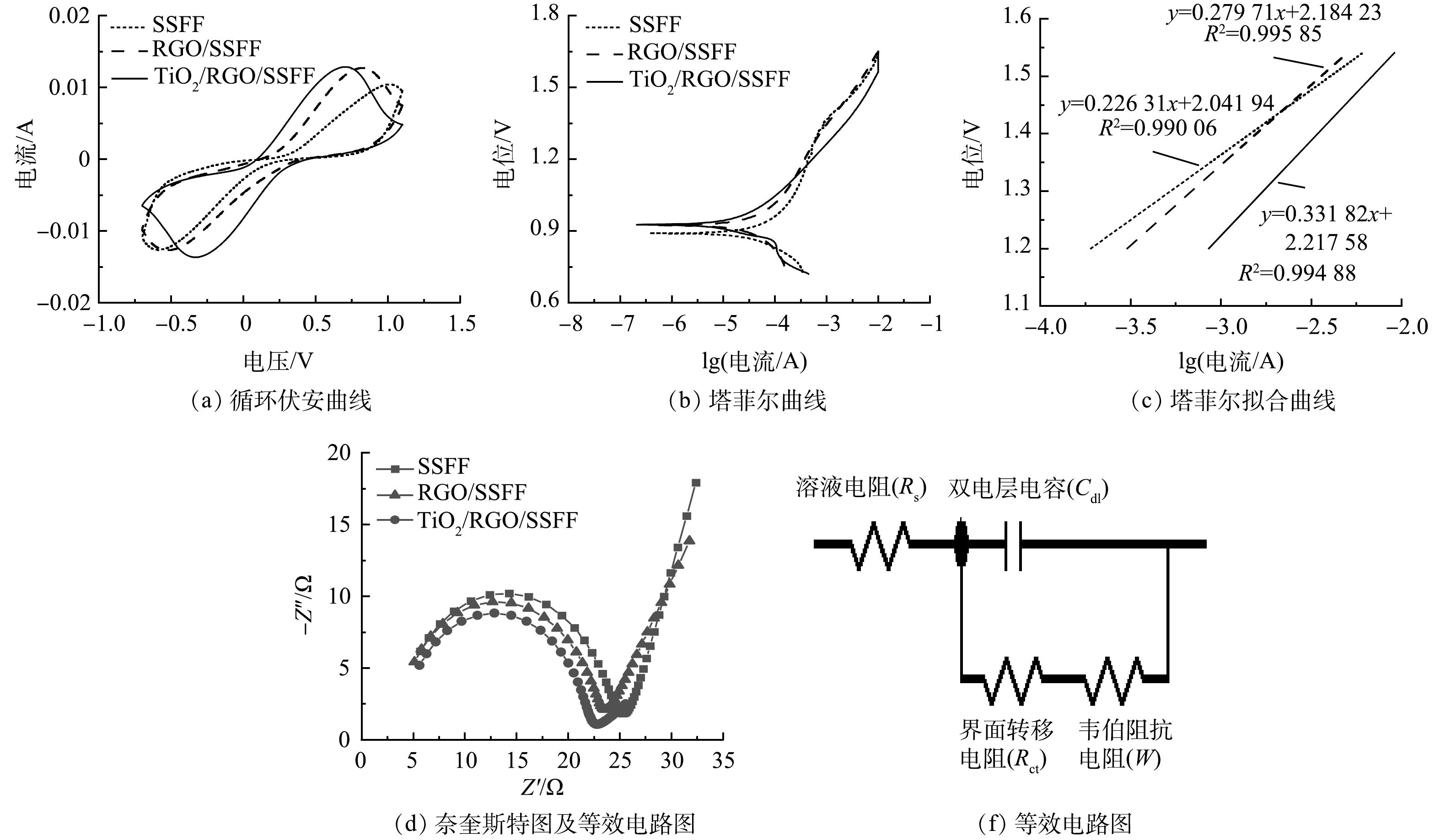
 下载:
下载:
